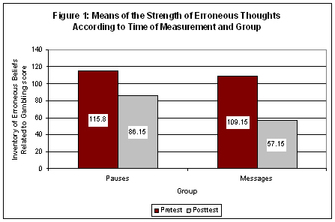Video lottery terminals (VLTs) are electronic devices that
allow gamblers to play a variety of games, including card games, roulette, and
spinning reel games. Multiple U.S. states and most Canadian provinces have
legalized VLTs, and recent studies have indicated that disordered gamblers
prefer VLTs to other games (e.g., Ladouceur, Sylvain, Boutin, & Doucet,
2002). Certain features of VLTs (e.g., lights and sounds, the speed at which
players can go from game to game, and the ability to stop the reels) might
increase cognitive errors and lead to increased gambling (Cloutier, Ladouceur,
& Sevigny, 2006; Griffiths, 1993; Ladouceur & Sevigny, 2005). In this
WAGER, we review two recent studies that examined the effect of
manipulating VLT characteristics on erroneous beliefs and persistence of play.
Study 1: Pop-Up Messages about Gambling Misperceptions
Cloutier et al. (2006) administered the Inventory of
Erroneous Beliefs Related to Gambling (ICROLJ) to 768 undergraduates at Laval
University. Students rated their agreement with a series of erroneous beliefs
using a scale from 0 to 10. Two months after initial contact with students, the
researchers selected for further participation in the study the forty students
who scored highest on erroneous beliefs about gambling. These participants were
randomized to either the control group, which received a 7 second pause after
every 15 games, or the experimental group, which received a pop-up message
correcting common misperceptions about gambling after every 15 games.
Researchers gave each participant 400 credits, equal to $20 Canadian dollars, to
play on a VLT as long as they wished. At the conclusion of the study,
participants completed the ICROLJ again to measure erroneous beliefs.
The analysis of the differences between the two groups found
that the experimental group had a significant decrease on strength of erroneous
beliefs, as measured by the ICROLJ, compared to the pause group (see Figure 1).
However, number of games played did not differ between the two groups.
Study 2: Stopping the Reels
Ladouceur and Sévigny (2005) recruited occasional video
lottery gamblers (defined as less than once per month) by using newspaper ads
and bulletin boards in Quebec City and on the Laval University campus. The
researchers excluded gamblers who scored five or above (i.e., qualified as
pathological gamblers) on a modified telephone version of the South Oaks
Gambling Screen (SOGS). The study design randomized 38 participants to either
the experimental group, in which participants played a VLT with a stopping
device (i.e., a feature that allows players to touch the screen in order to stop
play, but does not affect the outcome of the game), or the control group
whose VLTs had no stopping device. All participants experienced the same series
of wins and losses. The researchers gave all participants $10 for taking part in
the study and an additional $5 to begin play. Participants could stop at anytime
and receive the dollar amount of the credits remaining on their VLTs up to $20.
Participants in the experimental group played twice as many
games as participants in the control group, and nearly one third (32%) of the
experimental group reported that they believed using the stopping device
increased their chances of winning. The results of these studies are limited
mainly to college students and might not be replicated in a sample of regular
VLT users and problem gamblers. These studies were also conducted in controlled
settings that simulated a gambling atmosphere. Casinos have markedly different
environments that could modify behaviors and perhaps yield different results.
Together, these studies indicate that altering specific
aspects of VLTs might affect gambling beliefs and behavior for somewhat naïve
players. Though Cloutier et al. found that pop-up messages did not impact
behavior compared to controls, it is plausible that the seven second delay in
play experienced by the control group might have been an intervention that
decreased play by giving players time to consider their options. The ability to
change play patterns by altering VLT characteristics is a research area worth
pursuing. Future research should include larger samples and a population that is
not limited to college students. If VLT alterations such as messages, pauses,
and removing stopping devices decrease gambling problems even slightly, the
overall health improvement could be marked given the large proportion of problem
gamblers who prefer VLTs.
What do you think? Comments on this article can be addressed
to John Kleschinsky at basis@basisonline.org.
References
Cloutier, M., Ladouceur, R., & Sevigny, S. (2006).
Responsible gambling tools: pop-up messages and pauses on video lottery
terminals. Journal of Psychology, 140(5), 434-438.
Griffiths, M. (1993). Fruit machine gambling: The importance
of structural characteristics. Journal of Gambling Studies, 9(4),
387-399.
Ladouceur, R., & Sévigny , S. (2005). Structural
characteristics of video lotteries: effects of a stopping device on illusion of
control and gambling persistence. Journal of Gambling Studies, 21(2),
117-131.
Ladouceur, R., Sylvain, C., Boutin, C., & Doucet, C.
(2002). Understanding and treating pathological gamblers. London:
Wiley.





